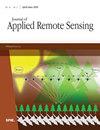Feasibility of remote estimation of optical turbulence via quick response code imaging
IF 1.4
4区 地球科学
Q4 ENVIRONMENTAL SCIENCES
引用次数: 0
Abstract
Turbulence estimation theory is presented and demonstrated by imaging a series of spatially encoded quick response (QR) codes in ambient radiation through atmospheric scintillation. This remote sensing concept was verified though preliminary feasibility experiments and detailed MATLAB simulations using QR codes displayed on a low-power digital e-ink screen. Of note, knowledge of propagation range and QR code dimensions are not required ahead of time, as each code contains information detailing its block size and overall physical size, enabling automated calculations of spatial resolution and target range. Estimation algorithms leverage the extracted resolution and range information to determine path-integrated optical turbulence, as quantified by the Fried parameter, r0. The estimation criterion is obtained by cycling a series of QR code sizes on an e-ink screen and determining the transition point at which the QR code can no longer be read, resulting in a system capable of automatically estimating path-integrated optical turbulence.通过快速反应代码成像远程估计光学湍流的可行性
通过大气闪烁对环境辐射中的一系列空间编码快速反应(QR)码成像,提出并演示了湍流估计理论。通过在低功耗数字电子墨水屏上显示 QR 码的初步可行性实验和详细的 MATLAB 仿真,验证了这一遥感概念。值得注意的是,无需提前了解传播范围和 QR 码尺寸,因为每个 QR 码都包含详细的区块大小和整体物理尺寸信息,从而可以自动计算空间分辨率和目标范围。估算算法利用提取的分辨率和距离信息来确定路径综合光学湍流,并通过弗里德参数 r0 量化。估算标准是通过在电子墨水屏幕上循环显示一系列 QR 码尺寸,并确定 QR 码无法再被读取的过渡点来获得的,从而形成一个能够自动估算路径积分光学湍流的系统。
本文章由计算机程序翻译,如有差异,请以英文原文为准。
求助全文
约1分钟内获得全文
求助全文
来源期刊

Journal of Applied Remote Sensing
环境科学-成像科学与照相技术
CiteScore
3.40
自引率
11.80%
发文量
194
审稿时长
3 months
期刊介绍:
The Journal of Applied Remote Sensing is a peer-reviewed journal that optimizes the communication of concepts, information, and progress among the remote sensing community.
 求助内容:
求助内容: 应助结果提醒方式:
应助结果提醒方式:


